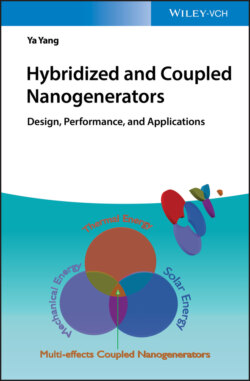Читать книгу Hybridized and Coupled Nanogenerators - Ya Yang - Страница 23
2.2 Conventional Wind Harvester 2.2.1 Working Mechanisms and Devices Structure
ОглавлениеHorizontal axis wind turbines (HAWTs) and vertical axis wind turbines (VAWTs) are two main types of conventional wind turbines (Figure 2.1a,b) [28,29]. They usually consist of three main parts, including a wind turbine, a cabin, and a tower. In the wind turbine, blades are very important, which can transform wind energy into the driving force of the turbine rotation. The mechanical energy from the driving force can be converted to electric energy by the generator. The tower not only bolsters the cabin but also limits the vibration produced by the change in the wind speed. The wind energy is defined as
(2.1)
where Ek is the wind energy, m is the wind mass, ν is the wind velocity, ρ is the air density, A is the area of the wind wheel, R is the length of the blade, and d is the thickness of the wind disk. According to the theoretical derivation, wind velocity is one of the key factors that affect wind power, and the power is given by
(2.2)
Figure 2.1 Main types of conventional wind turbines. (a) Horizontal axis wind turbines. (b) Vertical axis wind turbines. (c) Applications of micro‐wind turbines on homes.
Source: Reproduce with permission Ayhan and Sağlam [30]. Copyright 2012, Elsevier.
(d) Applications of turbines installation on urban expressways.
Source: Reproduced with permission from Ishugah et al. [28]. Copyright 2014, Elsevier.
HAWTs, which have the axis of rotation of the blades in a horizontal position, are widely used in urban environment because of their high efficiency. To effectively harvest wind energy, the propeller‐type rotor, which is mounted on a horizontal axis, uses a yaw motor to face the wind direction. The primal problems for these types of wind harvesters are the dangers to birds and aircraft due to their big blade sizes. The VAWTs adopt a vertical axis of rotation of blades, which is perfectly suitable for harvesting wind energy with different directions. In addition, the generator and gearbox of VAWTs can be mounted at ground level, making them easy to modulate and repair. Smaller VAWTs have been widely used in the urban environment because of their advantages of simple structures and low manufacturing cost.
